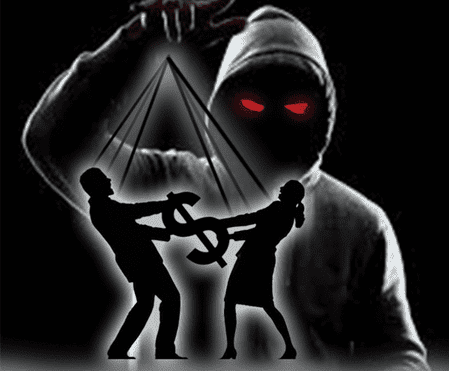I came across this on a message board. This is not my work, so I cannot take credit; however, the author's writing and message is worthy of repeating and I will post a link to the site below. It seems to me to be a constant struggle between those with power and those without it. The 'haves' and the 'have nots'.
The question: Is there a gender war going on in the United States?
Response by Tom Gi (from the West), 2014.
This is a very good question. I’ve found ‘the gender wars’ to be the hottest, most divisive, topic on the web. Ten years ago, after a young woman flamed at me at a forum, I added ‘women’s studies’ to my list of topics to research. A single man in my mid-forties, I was not looking forward to a ‘dig’ on the women’s movement. Boring, boring, boring. Yet once I started, I was hooked. It remains the most fascinating and illuminating topic I’ve researched. What really happened with SWF? (Second Wave Feminism) Why did it happen? And what are the consequences? Nothing, I believe, not cell phones or the internet, has had such a profound effect on the lives of Boomers and beyond. Here is what I’ve learned.
The first problem is distinguishing ‘the gender wars’ from what humorist James Thurber (creator of the character Walter Mitty) called ‘the war between men and women’. What Thurber is describing is as old as Adam and Eve. In Goethe’s ‘Faust’ Mephistopheles, a formerly condemned soul assisting Faust says, ‘I rather learn why man and wife must get along so badly.’ Shakespeare explores this ‘war’ in his play ‘The Taming of the Shrew’. There’s a short story by Ernest Hemmingway titled, ‘The Short Happy Life of Francis Macomber’ portraying a darker version. But whether it’s a romantic comedy or a tragedy, this ‘war between men and women’ is a constant of the human condition.
Enter Second Wave feminism (c. 1960s.)
SWF was the result of two converging influences (1) technology and affluence and (2) the rights revolution.
Technology and Affluence:
It is greatly overlooked in our modern world, that muscle power use to translate into social/economic power. In fact, that is why evolution provided men with such big arms compared to women. We had to fight each other to propagate our genes. Women were necessary; men were expendable. Consequently we are related to 80% of the women that have ever lived and only 40% of the men that have ever lived. And we still speak of ‘arms’ and ‘armies’.
However, in the 1950s, due to the machines that men designed, built, and maintained, the number of white collar workers began to outnumber the number of blue collar workers. It has often been said that the washing machine, vacuum cleaner, and the like, were the biggest factor in liberating women. It was a slow process. Women were taking on more and more prestigious jobs well before the 1960s. But something did change drastically during this time due to what Harvard psychologist Steven Pinker calls ‘the rights revolution’.
The Rights Revolution:
Due to our outrageous material and economic success in America and the West, we turned our attention to equality. In the 60s there was a frenzied crusade to root out all forms of oppression. Here are seven key aspects:
1.) Euro-centrism (race – discrimination against non-European races)
2.) Judeo-Christian centrism (religion – discrimination against non-Christian religions)
3.) Heterosexual-centrism (sexual orientation – discrimination against homosexuals)
4.) Elite-centrism (class – discrimination against the poor)
5.) Able-centrism (discrimination against the handicapped)
6.) Civilization-centrism (discrimination against primary cultures)
7.) Anthropo-centrism (environmentalism – discrimination against non-human species
It was called ‘the New Left’ in the 60s, the counter-culture fighting for the rights of these oppressed groups. But then we did something that was so diabolically clever it defies credibility: we declared ALL women an oppressed group. Then we introduced the idea of androgyny, that gender is a social construction. I can’t even begin to describe how clever and delusional this was.
Whether you are a man or woman, I really want you to think about this.
In 1912, when the Titanic went down, women were given priority in the lifeboats. Look at my list of oppressed groups. Can you even imagine any of these groups being given priority in those lifeboats? Women come from all classes, unlike certain ethnic minorities. The Vietnam Memorial has over 58,000 names. All but a handful are the names of men. This ratio is true of every war ever fought. To this day jobs that are dangerous and deadly are overwhelmingly male professions. We Americans pay our respect to the traditional male/female relationship in American Football, where men are out on the field risking concussions and broken bones, while the beauties with pompoms cheer on the sidelines. Sports is big in America. But by far the most popular issue of Sports Illustrated magazine is the swimsuit edition, generating 7% of the magazine’s income. In 2009 in America, there were 25% more female college grads than male college grads according to the Census Bureau. The suicide ratio of men to women is four to one. This is true across cultures and across generations. But how can life be so much harder for the oppressers compared to the oppressees?
We have been living a lie of female oppression. But why? Why does it persist? The answer is that there was something in it for both privileged women and men. Privileged women got unfettered access to high quality careers, adding social/economic power to their already formidable social and feminine power. Working outside the home is exhilarating if you have the opportunity to be a doctor, lawyer, college professor, or journalist. It isn’t all that special for a single mom, waitress, hair dresser, or sales clerk at Walmart.
But there was something in it for privileged men as well. Marriage laws were designed way back when to protect less powerful men from more powerful men, and less beautiful women from more beautiful women. When the new dating, mating, and marrying rules where adopted in the late 60s, it was to the benefit of privileged men. It’s not so wonderful for the blue collar worker who is single with three dependents. The rights revolution was founded on the notion of making a more equitable world. But ironically, this ‘New Deal’ of gender relationships does just the opposite.
In this new system, competition for both men and women is fiercer than ever. Men typically need to be more successful than their female mates to compensate for their lack of feminine power. American women, I’ve read, get 300,000 breast implants each year as they compete for fewer and fewer choice men. It is a system that benefits the few winners at the expense of many more less fortunate men and women. Not surprisingly, wealth disparity between rich and poor began to increase in the late 70s.
The new American dream is epitomized by Bill and Hillary Clinton, a power couple - Bill with his harem of ‘unimportant’ women, and a favorite among the feminist women who support him, and his very capable wife, who uses feminism, and the call for equality, as a power play.
It’s important, I think, to look at SWF in the context of the rights revolution in which it emerged. Wealthy white women, the most privileged group of individuals ever to exist on planet earth, could say that they have been oppressed for 5000 years. And all of the guilt over these other oppressed groups just disappears. Here is black feminist Gloria Watkins (Belle Hooks) writing in 2000:
“As many black women/women of color saw white women from privileged classes benefiting economically more than other groups from reformist feminist gains, from gender being tacked on to racial affirmative action, it simply reaffirmed their fear that feminism was really about increasing white power.” – “Feminism is for Everybody”, Gloria Watkins, 2000
“Privileged-class white women swiftly declared their “ownership” of the movement, placing working-class white women, poor white women, and all women of color in the position of followers. It did not matter how many working-class white women or individual black women spearheaded the women’s movement in radical directions. At the end of the day white women with class power declared that they owned the movement, that they were the leaders and the rest of us merely followers.” – “Feminism is for Everybody”, Gloria Watkins, 2000
* * *
Yes, there is a gender war. But it is not a war between men and women - not by a long shot. It is a war between those men and women who stake their claim to happiness and ethical superiority in the old system of dating, mating, and marriage, and those men and women who stake their claim to happiness and ethical superiority in the new system. It makes for a very bizarre tapestry, a glorious mess of coalitions, some men arguing for the virtue of feminism and some women arguing against it – all of this, mind you, layered on top of the age old constant of the ‘war between men and women’.
A challenging question.
"The Greatest Trick the Devil ever pulled was convincing the world he didn't exist."
― The Usual Suspects



 RSS Feed
RSS Feed
